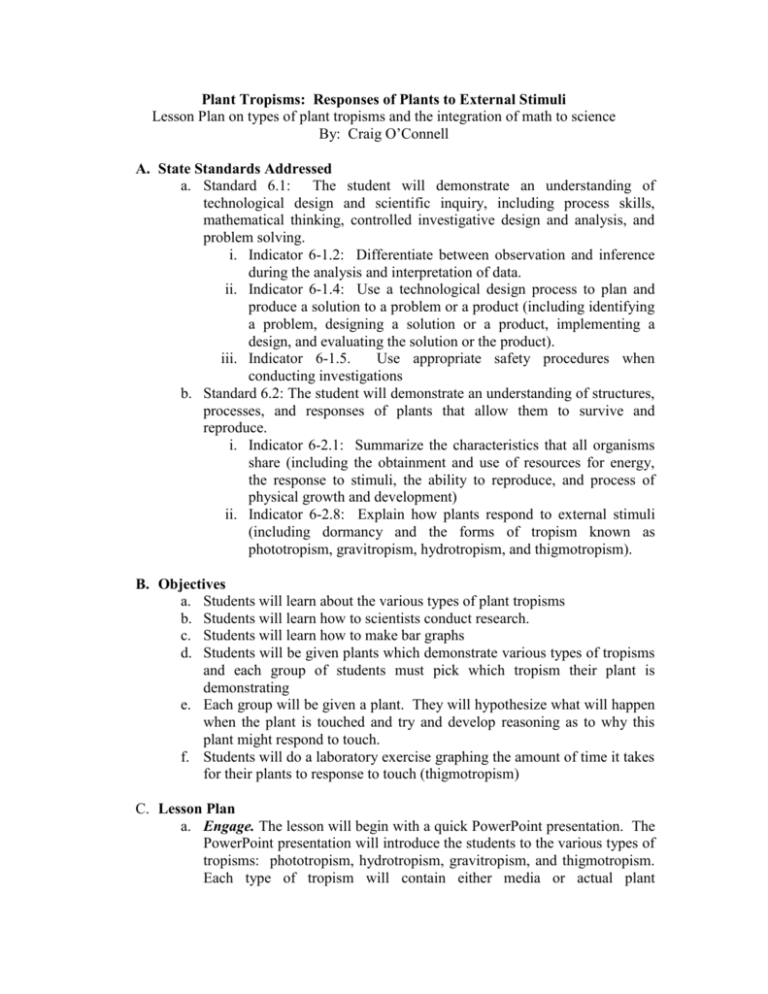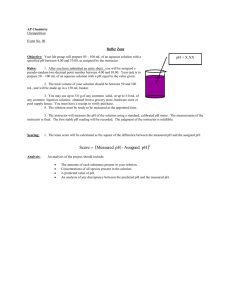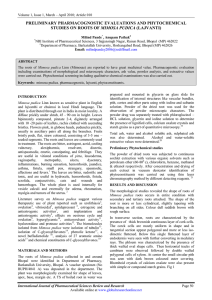Plant Tropisms: Responses of Plants to External Stimuli
advertisement

Plant Tropisms: Responses of Plants to External Stimuli Lesson Plan on types of plant tropisms and the integration of math to science By: Craig O’Connell A. State Standards Addressed a. Standard 6.1: The student will demonstrate an understanding of technological design and scientific inquiry, including process skills, mathematical thinking, controlled investigative design and analysis, and problem solving. i. Indicator 6-1.2: Differentiate between observation and inference during the analysis and interpretation of data. ii. Indicator 6-1.4: Use a technological design process to plan and produce a solution to a problem or a product (including identifying a problem, designing a solution or a product, implementing a design, and evaluating the solution or the product). iii. Indicator 6-1.5. Use appropriate safety procedures when conducting investigations b. Standard 6.2: The student will demonstrate an understanding of structures, processes, and responses of plants that allow them to survive and reproduce. i. Indicator 6-2.1: Summarize the characteristics that all organisms share (including the obtainment and use of resources for energy, the response to stimuli, the ability to reproduce, and process of physical growth and development) ii. Indicator 6-2.8: Explain how plants respond to external stimuli (including dormancy and the forms of tropism known as phototropism, gravitropism, hydrotropism, and thigmotropism). B. Objectives a. Students will learn about the various types of plant tropisms b. Students will learn how to scientists conduct research. c. Students will learn how to make bar graphs d. Students will be given plants which demonstrate various types of tropisms and each group of students must pick which tropism their plant is demonstrating e. Each group will be given a plant. They will hypothesize what will happen when the plant is touched and try and develop reasoning as to why this plant might respond to touch. f. Students will do a laboratory exercise graphing the amount of time it takes for their plants to response to touch (thigmotropism) C. Lesson Plan a. Engage. The lesson will begin with a quick PowerPoint presentation. The PowerPoint presentation will introduce the students to the various types of tropisms: phototropism, hydrotropism, gravitropism, and thigmotropism. Each type of tropism will contain either media or actual plant demonstrations. To engage the students, a variety of inquiry-based questions will be asked relating to why plants may respond to various stimuli. b. Explore. After the lecture the instructor will break the class into four different groups. Each group will be given a bug eating plant (sundew, purple pitcher, or Venus fly trap). Prior to observing the plants, as a class we will learn how scientists conduct research in the field. This will require the students to make observations, hypothesis/hypotheses and participate in an instructor led laboratory exercise. Students will learn how mathematics is a common technique researchers use to explore the scientific realm. i. Instructor will revisit independent vs. dependent variables. ii. Instructor will demonstrate how bar graphs are made: linking variables to their position on a graph iii. Instructor will lead class in a lab-based exercise explaining what will be done with each plant iv. Instructor will give each group one stopwatch v. Each group will drop one insect into each one of their plants and will record the amount of time it takes for one of their bug eating plants to feed (prior to this exercise, students will have watched a QuickTime video demonstrating how these plants feed so the students will know exactly what to look for) vi. Instructor will make table on board and as each group finishes, a group representative must write their feeding time on the board vii. Once each group completed the exercise, students will take out their lab manual and create graph (independent variable: Plant type or group number vrs. dependant variable time of capture). viii. Instructor will assist in graph making and will ask students to discuss results to determine if there were differential responses by plant/group and why these differences occurred. c. Explain and Elaborate. After this exercise, students will remain in the same groups and each group will be given one mimosa pudica plant (sensitive house plant). Students must not touch the plant prior to exercise. Instructor will lead this lab and tell the students that this plant is a rainforest plant that exhibits thigmotropism. Students will be asked what thigmotropism is (review) and will be instructed to write definition down in their lab manual. Following this definition, students will have to make a hypothesis about what will happen when they touch the leaves of this plant. Steps of this experiment will be: i. Each group will have one stopwatch ii. Teacher will make table on board which will require each group to list their data iii. Each group will touch their plant and record the amount of time it takes for the leaves to fully close and stop moving. Once they stop iv. v. vi. vii. moving each group will write down the time and will restart the stopwatch. Students will then start timing again to record the amount of time it takes for the leaves to fully open back up again (maximum 3 minutes). Students will write data on board Students will look at previous graph they made and use that to help them construct two different graphs in their lab manual: 1. Time for Mimosa pudica to close 2. Time for mimosa pudica to reopen After constructing graphs, instructor will lead an inquiry-based exercise having the students try to determine if all the plants reacted the same way. If any difference occurs, students should be asked to develop possible explanations as to why this difference occurred. Answers will be written in lab manual under a conclusions section. d. Evaluate. This lab will be graded by a journal assessment. To be included in their journal entry: i. Various types of tropisms ii. Hypotheses iii. Observations iv. Results (all three graphs: teacher-led graph and two student graphs) v. Conclusion: Why do you think plants responded this way? 1. 2. 3. Post Lesson Notes from Teacher: This was a very exciting exercise for the students and was easy to accomplish in a 100 minute lesson. Students struggled with the graphing exercise but it was important for them to understand how math is integrated in science. This is an excellent exercise that will really enhance a plant unit in any grade level. Seeing a plant move after a bug touches it or after they touch it is almost magical to them and quickly gets the students engaged to learn.







